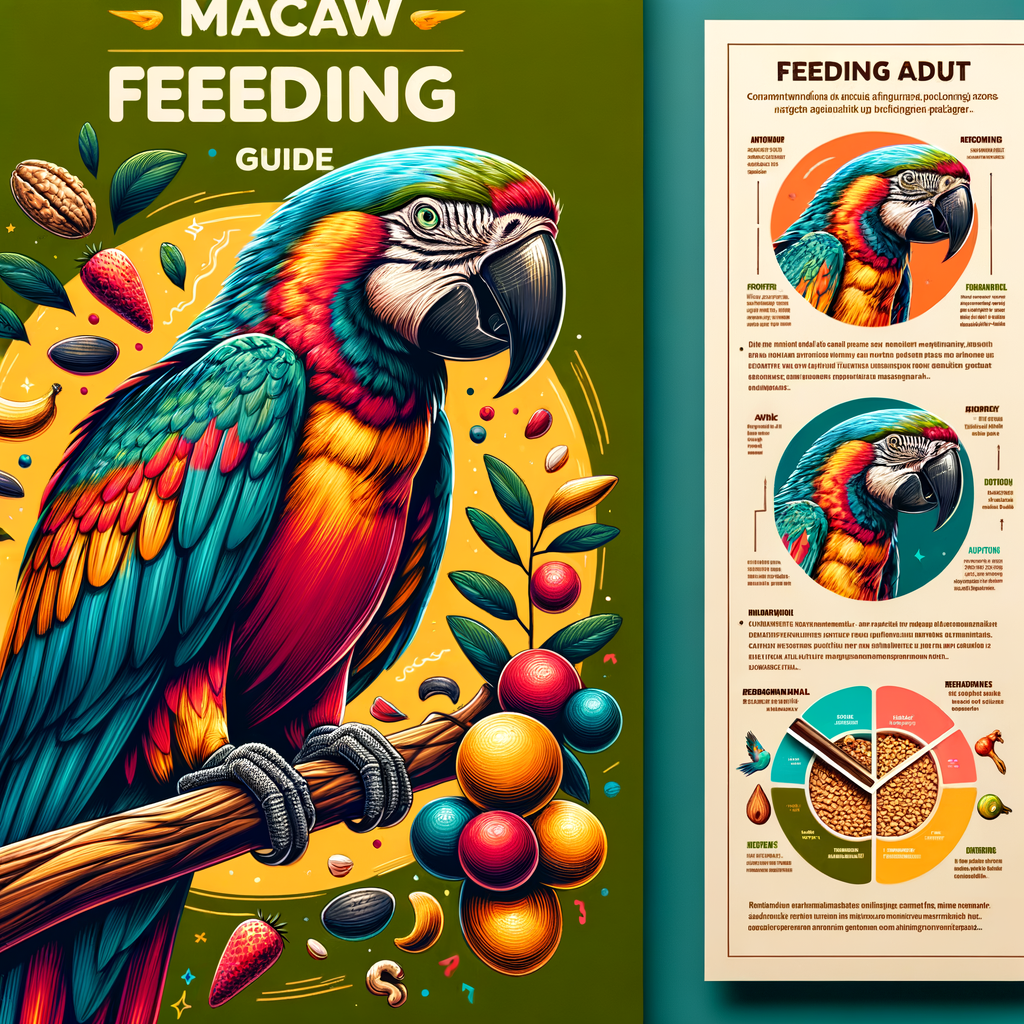
Introduction to Macaw Mealtime Rituals
Macaws, vibrant and intelligent birds, have unique mealtime rituals that play a crucial role in their behavior and overall health. This introduction will help you understand the importance of mealtime in Macaw behavior and provide an overview of their feeding habits.
- Understanding the importance of mealtime in Macaw behavior
- Overview of Macaw feeding habits
Mealtime for Macaws is not just about nourishment, but it’s also a time for social interaction and learning. In the wild, Macaws often feed in groups, using this time to communicate and bond with each other. This behavior is crucial for their social development and overall well-being. In captivity, it’s important to mimic these natural behaviors to ensure the Macaw’s health and happiness.
Macaws are primarily herbivores, feeding on a diet rich in fruits, nuts, and seeds. However, they also consume small amounts of insects and snails for protein. In the wild, Macaws have a broad diet, often traveling great distances to find food. They use their strong beaks to crack open hard-shelled nuts and seeds. In captivity, it’s essential to provide a varied diet that mimics their natural feeding habits to ensure they receive all the necessary nutrients.
In the following sections, we will delve deeper into the Macaw diet, their feeding habits, and case studies on Macaw feeding behavior. By understanding these aspects, we can better care for these magnificent creatures and ensure their longevity and health.
Understanding Macaw Diet
When it comes to understanding the diet of a Macaw, it’s important to note that these vibrant birds have specific food preferences. Let’s delve into what they typically eat and their favorite treats.
Macaw Food Preferences
Macaws are known for their vibrant colors and their equally vibrant diet. They have a wide range of food preferences, which are essential to their health and happiness. Here are some of the most common foods in a Macaw’s diet and their favorite treats:
- Common foods in a Macaw’s diet: Macaws are primarily herbivores. They enjoy a variety of fruits, vegetables, nuts, and seeds. Some of their favorites include apples, bananas, carrots, and sunflower seeds. They also enjoy grains such as quinoa and brown rice. It’s important to provide a variety of these foods to ensure they get all the nutrients they need.
- Macaw’s favorite treats: While Macaws enjoy their regular diet, they also love treats. These can include special fruits like mangoes and papayas, or even a small piece of cheese. However, treats should be given sparingly and make up only a small part of their overall diet.
Remember, each Macaw may have its own unique preferences. It’s important to pay attention to what your Macaw enjoys eating and adjust their diet accordingly. The key is to provide a balanced diet that includes a variety of foods.
Macaw Nutrition
When it comes to the health and happiness of a Macaw, nutrition plays a crucial role. Let’s dive into the nutritional needs of a Macaw and understand why a balanced diet is so important for these vibrant birds.
- Nutritional Needs of a Macaw
- Importance of a Balanced Diet for Macaws
Macaws, like all parrots, are omnivores. This means they need a varied diet to get all the nutrients they require. A healthy Macaw diet should include a mix of seeds, nuts, fruits, and vegetables. However, seeds and nuts should not make up the majority of their diet as they are high in fat. Instead, fresh fruits and vegetables should be the main part of their diet.
Macaws also need a good amount of protein in their diet. This can be provided through cooked lean meats, eggs, and legumes. Additionally, they require calcium for strong bones and beak health, which can be supplied through cuttlebone or mineral blocks.
A balanced diet is vital for a Macaw’s overall health and well-being. It helps to maintain their vibrant feathers, supports their immune system, and promotes a long, healthy life. Without a balanced diet, Macaws can suffer from a range of health issues, including obesity, heart disease, and liver problems.
Moreover, a balanced diet also influences a Macaw’s behavior. A well-fed Macaw is more likely to be active, playful, and sociable. On the other hand, a Macaw that is not getting the right nutrients may become lethargic, aggressive, or develop behavioral problems.
| Macaw Nutritional Needs | Sources |
|---|---|
| Protein | Cooked lean meats, eggs, legumes |
| Calcium | Cuttlebone, mineral blocks |
| Fruits and Vegetables | Fresh produce, avoid avocado and certain seeds |
In conclusion, understanding and providing for the nutritional needs of a Macaw is essential for their health and happiness. By providing a balanced diet, you are setting your Macaw up for a long, vibrant, and healthy life.
Macaw Feeding Habits
Understanding the feeding habits of macaws is crucial for anyone who owns or plans to own these vibrant birds. In this section, we will delve into the eating patterns of macaws, including their typical eating schedule and their unique feeding behavior.
Macaw Eating Patterns
Macaws, like many other birds, have specific eating patterns that are unique to their species. Let’s explore these patterns in detail.
- Typical eating schedule for a Macaw
- How Macaws eat: their unique feeding behavior
Macaws typically eat twice a day, once in the morning and once in the evening. This schedule aligns with their natural feeding habits in the wild, where they would forage for food at dawn and dusk. It’s important to note that while this is a typical schedule, individual macaws may have slightly different preferences.
Macaws have a unique feeding behavior that sets them apart from other birds. They use their strong, curved beaks to crack open hard shells and reach the nutritious seeds inside. Additionally, macaws use their agile feet almost like a third hand, holding food items while they eat. This behavior is not only fascinating to watch but also serves as an indicator of a healthy and happy macaw.
Understanding these feeding habits can help you provide the best care for your macaw. In the next section, we will provide a practical guide on how to feed a macaw, including common mistakes to avoid.
Macaw Feeding Guide
Feeding a Macaw is not just about providing food. It’s about understanding their dietary needs and habits. Let’s explore some practical tips and common mistakes to avoid when feeding a Macaw.
- How to feed a Macaw: practical tips
- Variety is key: Macaws need a variety of fruits, vegetables, and nuts in their diet. This not only provides them with essential nutrients but also keeps them interested in their food.
- Consistent feeding times: Macaws thrive on routine. Try to feed your Macaw at the same times each day.
- Monitor portion sizes: Overfeeding can lead to obesity in Macaws. It’s important to monitor portion sizes and adjust as necessary.
- Hydration is important: Always ensure your Macaw has access to fresh, clean water.
- Common mistakes to avoid when feeding a Macaw
- Feeding only seeds: While seeds are part of a Macaw’s diet, they should not be the only food source. A diet solely based on seeds can lead to nutritional deficiencies.
- Ignoring fresh foods: Fresh fruits and vegetables are essential for a Macaw’s health. Ignoring these can lead to health problems.
- Irregular feeding times: As mentioned earlier, Macaws thrive on routine. Irregular feeding times can cause stress and health issues.
- Not providing enough water: Macaws need constant access to fresh water. Not providing enough can lead to dehydration.
Feeding a Macaw requires a balanced diet and a consistent feeding schedule. Here are some practical tips:
While feeding a Macaw may seem straightforward, there are common mistakes that can negatively impact their health. Here are some to avoid:
In conclusion, feeding a Macaw requires understanding their dietary needs and habits. By following these practical tips and avoiding common mistakes, you can ensure your Macaw is healthy and happy.
Case Studies: Macaw Feeding Behavior
Let’s dive into some real-life case studies to understand Macaw feeding behavior better. These studies will provide us with valuable insights into their dietary habits and how their diet impacts their behavior.
- Case Study 1: Observing Macaw Feeding Habits in the Wild
- Case Study 2: The Impact of Diet on a Macaw’s Behavior
In this study, researchers spent several months observing Macaws in their natural habitat. They found that Macaws are not picky eaters. They eat a variety of fruits, nuts, and seeds available in their environment. Interestingly, they also observed that Macaws have a unique feeding habit. They often visit clay licks, which are river banks rich in minerals. Macaws eat this clay to neutralize the toxins found in some of their food. This behavior is unique to Macaws and a few other bird species.
In another study, researchers examined the impact of diet on a Macaw’s behavior. They found that diet plays a significant role in their behavior. Macaws fed with a balanced diet were observed to be more active and social. On the other hand, Macaws with an inadequate diet were less active and showed signs of stress and aggression. This study highlights the importance of a balanced diet for the overall health and behavior of Macaws.
These case studies show us that Macaw feeding behavior is not just about eating. It’s also about their survival and well-being. They have adapted to their environment in unique ways to ensure they get the nutrients they need. It also shows us that providing a balanced diet is crucial for their health and behavior.
Key Takeaways: Decoding Macaw Mealtime
As we wrap up our discussion on Macaw mealtime, let’s revisit the key points that we have learned. These insights will not only help you understand your Macaw better but also ensure that you provide them with the best care and nutrition.
- Understanding Macaw behavior through their feeding habits
Macaws have unique feeding habits that can tell us a lot about their behavior. For instance, they often use their feet to hold food while they eat, a trait that showcases their intelligence and adaptability. Observing your Macaw during mealtime can provide valuable insights into their health and well-being. Changes in their eating habits can often signal health issues, making it crucial for you to pay close attention.
- Importance of nutrition in a Macaw’s diet
Macaws require a balanced diet to stay healthy and vibrant. Their diet should consist of a variety of fruits, vegetables, grains, and proteins. A well-nourished Macaw will have bright feathers, clear eyes, and a lively demeanor. Remember, a healthy diet is key to a long and happy life for your Macaw.
- Practical tips for feeding a Macaw
Feeding a Macaw is not just about what you feed them, but also how you feed them. Here are some practical tips:
- Feed your Macaw at regular intervals to establish a routine.
- Provide fresh water at all times.
- Remove any uneaten food to prevent spoilage.
- Monitor your Macaw’s weight and adjust their diet as needed.
Understanding and implementing these key takeaways will help you ensure that your Macaw is well-fed, healthy, and happy. Remember, a well-cared-for Macaw is a joy to have around!






